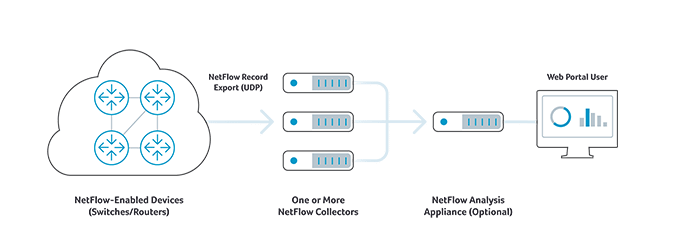NetFlow Collector
Understanding the inner workings of a network can be a complex task. An essential tool in the arsenal of any network administrator is the NetFlow Collector. These powerful applications are vital in managing and analyzing network flow data and can help ensure optimal network performance and capacity planning. This article delves into what a NetFlow Collector is, its main functions, limitations, and modern approaches to its implementation.
What is a NetFlow Collector?
A NetFlow Collector is a network application that receives, processes, and stores NetFlow records. These records are data about network flow exported from network devices such as routers and switches. Developed by Cisco Systems, NetFlow is a protocol that tracks critical statistics and information about IP packet flows.
A NetFlow Collector is part of a three-component system used for NetFlow analysis that includes a NetFlow Exporter and a NetFlow Analyzer. While the NetFlow Exporter tracks and generates flow records, the NetFlow Collector receives and organizes these records. The NetFlow Analyzer then uses this data for network performance monitoring, troubleshooting, and capacity planning tasks.
The basic functions of these components are described below:
- NetFlow Exporter: a NetFlow-enabled router, switch, probe or host software agent that tracks key statistics and other information about IP packet flows and generates flow records that are encapsulated in UDP and sent to a flow collector. In cloud environments, NetFlow-like data can be exported in the form of VPC Flow Logs (also known as cloud flow logs).
- NetFlow Collector: an application responsible for receiving flow record packets, ingesting the data from the flow records, pre-processing and storing flow record from one or more flow exporters.
- NetFlow Analyzer: a software application that provides tabular, graphical and other tools and visualizations to enable network operators and engineers to analyze flow data for various use cases, including network performance monitoring, troubleshooting, and capacity planning.

Main Functions of NetFlow Collectors
A NetFlow Collector’s main functions include:
- Ingesting flow UDP datagrams from one or more NetFlow-enabled devices
- Unpacking binary flow data into text/numeric formats
- Performing data volume reduction through selective filtering and aggregation
- Storing resulting data in flat files or SQL database
- Synchronizing flow data to the NetFlow Analyzer application running on a separate computing resource
NetFlow Collector and Netflow Analyzer applications are two functions of a NetFlow analysis system or product. In some cases, the NetFlow analysis product implements both functions on the same server. This is appropriate when the volume of flow data being generated by exporters is relatively low and localized.
In cases where flow data generation is high, or where sources are geographically dispersed, the collector function can be run on separate and geographically-distributed servers (such as rackmount server appliances). In these cases, collectors then synchronize their data to a centralized analyzer server.
Limitations of Physical NetFlow Collectors
Historically, the most common way to run NetFlow collectors was on a physical, rackmounted Intel-based server running a Linux OS variant. More recently, flow collectors have been deployed on virtual machines. Unfortunately, in either case, compute and storage severely limits the amount of detailed network flow data that could be retained and analyzed.
Cloud-scale NetFlow Collectors
Most recently, a unified, cloud-scale approach to NetFlow collector and analyzer architectures has emerged. In this architecture, a horizontally-scalable, big data system replaces physical or virtual collector and analyzer appliances. Big data systems allow for dramatically higher volumes of data ingest, longer data retention periods, deeper network traffic analytics and more powerful anomaly detection. To learn more about modern approaches to NetFlow analysis, visit the Kentik Platform overview page.
Releated Reading and Resources
- Kentipedia: NetFlow Overview
- NetFlow Guide: Types of Network Flow Analysis
- Kentipedia: NetFlow Tools
- Looking for the best NetFlow collector? Try Kentik today… it’s free to get started today.


